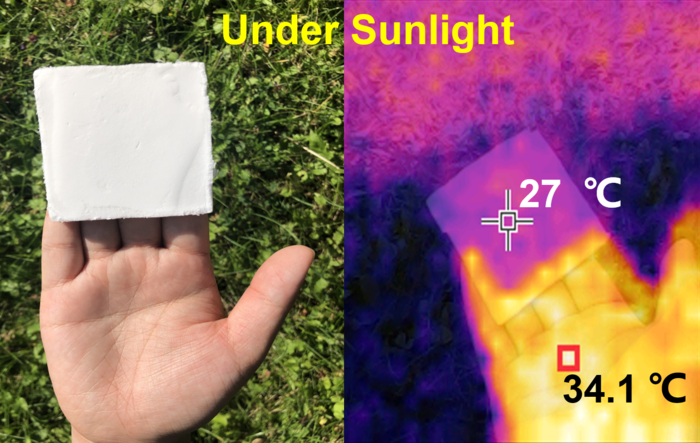During summertime people, make an attempt to beat the heat. However, running air conditioners is costly and wasteful.
 A lightweight foam (left image) made from cellulose nanocrystals keeps it cool in the sun (pink box; right image). Image Credit: Adapted from Nano Letters, 2022.
A lightweight foam (left image) made from cellulose nanocrystals keeps it cool in the sun (pink box; right image). Image Credit: Adapted from Nano Letters, 2022.
At present, scientists have developed a lightweight foam composed of wood-based cellulose nanocrystals reflecting sunlight, liberating absorbed heat, and is thermally insulating. The material could potentially decrease buildings’ cooling energy requirements by more than a third.
The study has been reported in the ACS’ Nano Letters journal.
Even though researchers have come up with cooling materials, these materials do have their drawbacks. Some materials that passively tend to release absorbed heat let a lot of heat through to buildings under the direct, midday sun of the summer months.
Also, other materials that tend to reflect sunlight do not work well in hot, humid or cloudy weather. Hence, Yu Fu, Kai Zhang, and collaborators wished to develop a strong material that has the potential to reflect sunlight, passively liberate heat, and keep wayward heat from passing through.
To produce a cooling material, the scientists linked cellulose nanocrystals collectively with a silane bridge, prior to freezing and freeze-drying the material under a vacuum. This process aligned the nanocrystals in a vertical position, thereby creating a white, lightweight foam, which reflected 96% of visible light and liberated 92% of absorbed infrared radiation.
When placed over an aluminum foil-lined box sitting outdoors at noon, the material maintained the temperature within the box 16 °F cooler than the outside. Furthermore, the material kept the inside of the box 13 °F cooler when the air was comparably humid.
As there was a compression in the cellulose-based foam, its cooling potential decreased, thereby disclosing tunable cooling properties. The team assessed that positioning the foam on the roof and exterior walls of a building could decrease its cooling energy needs by an average of 35.4%.
Since the wood-based cellulose foam’s performance could be tuned based on weather conditions, the researcher stated that the technology could be employed in a wide range of surroundings.
The study authors acknowledge financial support from the German Research Foundation (DFG), Lower Saxony Ministry of Science and Culture, the National Natural Science Foundation of China, and Jiangsu Specially appointed Professorship Program.
The Science and Technology Innovation Project for Overseas Students of Nanjing City, the Postgraduate Research & Practice Innovation Program of Jiangsu Province, National First-class Disciplines (PNFD), the Jiangsu Government Scholarship for Overseas Studies, and the China Scholarship Council also funded the research.
Journal Reference:
Cai, C., et al. (2022) Dynamically Tunable All-Weather Daytime Cellulose Aerogel Radiative Supercooler for Energy-Saving Building. Nano Letters. doi.org/10.1021/acs.nanolett.2c00844.
Source: https://pubs.acs.org/